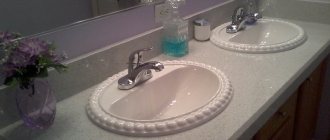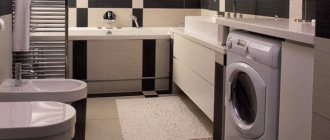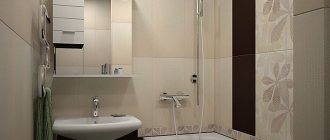The most important moment of repair is the final stage. In this section, final work is carried out, which is designed to make the shower room not only attractive in appearance, but also completely ready for use and various loads. Bathroom baseboards are one of the most common and reliable ways to make a space meet all the necessary requirements.
The overall appearance of the room directly depends on the correct choice of baseboard for the shower room floor. Today, when decorating a bathroom, the minimalist style is very common. It includes the installation of a sink, bathtub, and a small washing machine. Usually the walls are painted, ceramics are laid, and the seams are sealed using a special mortar.
Thus, the seams have to be adjusted several times a year, which, of course, requires some patience. Currently, curb cement or ordinary paint are no longer the most technologically advanced way out of this situation. Bathroom baseboards have become an excellent alternative! It surpasses them in price, performance characteristics, prevents moisture from entering joints, and also improves the appearance of the room and floor.
Types of floor skirting boards for the bathroom
There are many different finishing materials that can be used in decorating a bathroom. Just like the threshold in the bathroom, the baseboard needs to be chosen so that it matches the overall design of the room.
Depending on the type of material, the baseboard for the bathroom floor can be:
- ceramic – beautiful and functional;
- plastic – easy to install, flexible and versatile (about
Primary requirements
Floor skirting boards are installed in the bathroom to solve two main purposes. Firstly, they give the renovation a finished look by covering the gaps between the floor and wall coverings. Secondly, their presence provides additional waterproofing, since water will get into open cracks. Basic requirements for borders:
- the material should not absorb moisture and be destroyed under its influence;
- products must be durable;
- the baseboard material should not contribute to the spread and growth of mold fungi;
- the border should be compatible in design with other finishing materials.
Ceramic baseboard
If the decoration in the bathroom is made of ceramic tiles, then it would be logical to use a baseboard made of the same material. Ceramic plinth has the following characteristics:
- wear resistance;
- moisture resistance;
- does not change its shape;
- the color does not fade over time;
- easy to care for;
- has chemical resistance;
- resistance to sudden temperature changes;
- durable unless dropped or hit with something very heavy.
Manufacturers have not previously produced ceramic skirting boards. Therefore, instead, tiles cut to the required sizes were used, and very often its color differed from the color of the finish, but was very close to it.
Today, ceramic skirting boards are produced in large quantities. It is produced both separately and in a collection with tiles. Skirting boards can be of various sizes, shades and shapes, and are also produced in the form of corners. Basically, the dimensions of the floor plinth are more or less standard.
As a rule, the baseboard is also purchased immediately along with the tiles. You should choose baseboards and tiles that match each other, and everything should be in harmony with the overall design of the room. The amount of material should be taken 5-10% more than required, and you must not forget to buy corners.
Ceramic plinths are laid, like tiles, using a special tile adhesive. This type of skirting board is more difficult to install than a plastic one, since it does not have plasticity. Before the glue has set, you should very carefully adjust all the elements.
This plinth, unfortunately, can not be found in all localities. Therefore, they come out of the situation depending on the current situation. There are specialists who construct the floor in such a way that there are no gaps between the wall and the floor, and accordingly, there is no need for a plinth.
How to glue a skirting board to a bathtub - step-by-step diagram
Step 1: Surface Preparation
First we need to prepare the walls and tiles - we wipe them with a dry cloth where we will install the border, since the surface must be dry. By the way, in order for the material to lie flat, it is necessary to make the wall even. To do this, you need to clean and plaster the walls. If for some reason you are unable to carry out this work, use a flexible border that can easily change shape.
Step 2: Seal the cracks
Next, we seal the gaps between the bathtub and the walls using aquarium sealant, which should dry for at least a day. Be sure to cover the edges of the bathtub with masking tape; otherwise, when installing the baseboard, there is a high risk of damaging its enamel.
Step 3: Trimming the Skirting Boards
We measure the required distance of the baseboard and cut it into pieces, each of them should correspond to the side of the bathroom.
Step 4: Working with Liquid Nails
Apply glue or liquid nails to the wall and leave for 7-10 minutes, after which we firmly press the border with one side to the bathtub, and the other to the wall. You can also use plugs and corners, which make it much easier to join the skirting boards together, improving the appearance.
Plastic skirting board
A plastic baseboard on the bathroom floor can be used for almost all types of interior decoration. This type of plinth is inexpensive and comes in a large number of colors.
It has the following characteristics:
- moisture resistant;
- not exposed to fungus and mold;
- thanks to the existing rubber edges, it fits tightly to the surface;
- the surface is smooth and even, does not require painting, and a large selection of colors allows you to choose a baseboard that will look harmonious in the overall interior of the bathroom. Tips on how to choose a baseboard color will help you figure it out;
- durable enough;
- if it is not glued, then it is possible to dismantle it and install it again;
- easy to install;
- has space for cables and necessary accessories;
- easy to care for, detergents will not damage it.
The plastic plinth is fixed to the tile using “liquid nails”. If there are small cracks, they are sealed with silicone sealant. Most specialists use tile adhesive when installing skirting boards.
Common Mistakes
- Take transparent glue. It is not always possible for a plastic baseboard to be pressed tightly against the wall along its entire length. There may be a gap left somewhere. All these cracks must be sealed. This means that somewhere, one way or another, the glue will be visible. If it is transparent, it will not be noticeable.
- Choose an adhesive that sets quickly. This is important because you will be holding the baseboard with your hands for some time. In order not to hold it for too long, the glue needs to have some initial quick adhesion force.
- Don't be lazy to remove excess glue immediately. Once it dries, it can only be removed mechanically. This is difficult to do without damaging the baseboard itself or part of the tiles on the wall.
- Choose an adhesive or sealant with antibacterial additives. Otherwise, after a couple of months the baseboard will have to be torn off and the fungus cleaned out. This takes a lot of time and nerves.
- To prevent the bathroom border from falling off over time, stick it only to the wall. The lower part of the baseboard is simply pressed down. The fact is that the bathtub moves a little when used. This small movement is enough for the baseboard to fall off if it is glued to the bathtub. If you are not satisfied with this option, then glue the baseboard to the sealant, it has a reserve of elasticity. Look for a sealant based on MS polymers.
- If you are gluing a baseboard to a bathtub that has an adhesive base, then practice how you will place it without removing the protective tape. The fact is that if you install the baseboard incorrectly the first time, it will be very difficult to remove it. Even if you tear it off, parts of the adhesive tape will remain on the bathtub.
- Bathroom curbs without adhesive are more reliable than those with adhesive. The fact is that the adhesive tape has its own thickness, and even a strongly pressed plinth will not sit as tightly as if we glued it with glue. If you have a baseboard with an adhesive backing, we advise you to tear it off and glue the baseboard with glue. How to do this was described above.
Metal baseboard
A metal baseboard for a bathroom floor has the following characteristics:
- strength, this indicator is much higher than that of other types of skirting boards;
- duration of service life;
- immunity to temperature changes;
- moisture resistance;
- easy to maintain as it does not react to detergents.
In addition, various wires can be laid under the baseboard. The metal version of the plinth most often used is the one made of aluminum. Its cost is high, so it is rarely used in apartment interiors. However, such a plinth looks luxurious, beautiful and unusual, and is a unique part of the decor.
Self-adhesive skirting board
This bathroom floor plinth is a polyurethane tape that has the following features:
- moisture resistance;
- rot resistance;
- does not change due to temperature changes;
- very easy to install;
- long period of operation;
- easy to care for;
- wide range of colors, produced in various widths.
Water may cause limescale to appear on the baseboard. It is very easily removed using cleaning products that do not contain abrasive substances so that scratches do not form.
This type of plinth is installed as follows: the protective layer is removed from the adhesive surface, then gradually unwinding the roll, the tape is glued to the required place. Self-adhesive skirting boards install faster than other types of skirting boards.
Materials and tools
In order to glue the ceiling plinth, in addition to the fillets themselves and glue, you will need the following tools and equipment:
- step ladder,
- stationery knife,
- miter box,
- roulette,
- ruler,
- putty knife.
Finishing materials and tools you may need:
- silicone sealant,
- putty,
- water-based or acrylic paint,
- brushes,
- sandpaper.
Choosing the color and width of the plinth
The plinth is selected depending on the color scheme of the floor covering. If you choose it in the same color as the floor, it will look like a single whole. To emphasize the line between the floor and the wall, you need to choose a contrasting color or it should differ in color by several tones. Nowadays, more and more often, the color of the plinth is chosen to match the tone of the walls, rather than the floor.
Even a plain white baseboard will look like a small accent in the design of the room if the overall color background is chosen correctly. You can experiment, look at several options and choose the best one.
The following factors influence the choice of plinth height:
- room size;
- bathroom geometry;
- ceiling height;
- color scheme for finishing the floor, walls and ceiling. If the bathroom is large, then the height of the plinth should be appropriate to the size of the room, that is, higher compared to the plinth in a small bathroom with low ceilings.
You should adhere to proportions and choose the right combination of colors, then the bathroom interior will look elegant, and the baseboard will give it a complete look.
General information
Types of skirting boards
On the construction market you can find several types of bathroom borders:
- Tape.
- Plastic.
- Ceramic.
Strip plinth is made of polyethylene with different width sizes. On one side the strip plinth has a self-adhesive tape.
Please note that when installing strip plinth, it is recommended to fix the adhesive layer with sealant.
Plastic bathroom baseboards are considered the most economical option and are also easy to install. It can be mounted both under and on tiles.
Ceramic borders are available on the market and in specialty stores in various designs, both in size and color. This is the optimal solution for those people who have decided to renovate and want the plumbing fixtures and all bathroom accessories to last as long as possible.
Advantages and disadvantages of ceramic baseboards for the bathroom
Ceramic finishing material is distinguished by its wear resistance and durability.
Thanks to its unique chemical composition and characteristics, ceramic plinths have many advantages:
Hygiene.- Environmentally friendly.
- Resistant to high levels of humidity and deformation.
- Good tensile strength.
- Hardness.
- Resistance to temperature changes.
These skirting boards perfectly retain their original color for a long time. The only disadvantage of the products is the below average level of resistance to mechanical stress. It turns out that when a heavy object falls on the baseboard, the first one may split or become covered with cracks.
Types of ceramic border
The difference between ceramic baseboards for the bathroom lies in the form of execution.
Pencil. This is a thin and convex ceramic strip. It is used to close small gaps. With the help of thin borders you can zone the bathroom and even create unusual edgings for the mirror. This type of plinth is produced in different shades.
Angular. This is a ceramic border with a triangular cross-section. This type of skirting board is usually installed to the surface of the wall and bathtub, and glue is used. Corner skirting boards are made with patterns, as well as plain and in different colors.
Frieze. This is a narrow plinth that can be convex and corrugated. Its length is equal to the width of the tile. They are made in different colors and decorated with patterns and designs.
Manufacturers are trying to complete the collection with borders and corner elements, with the help of which installation is greatly facilitated and the perception of corners in an aesthetic sense is much better.











